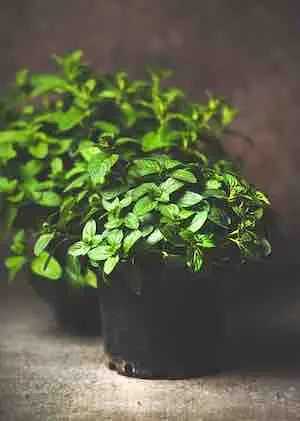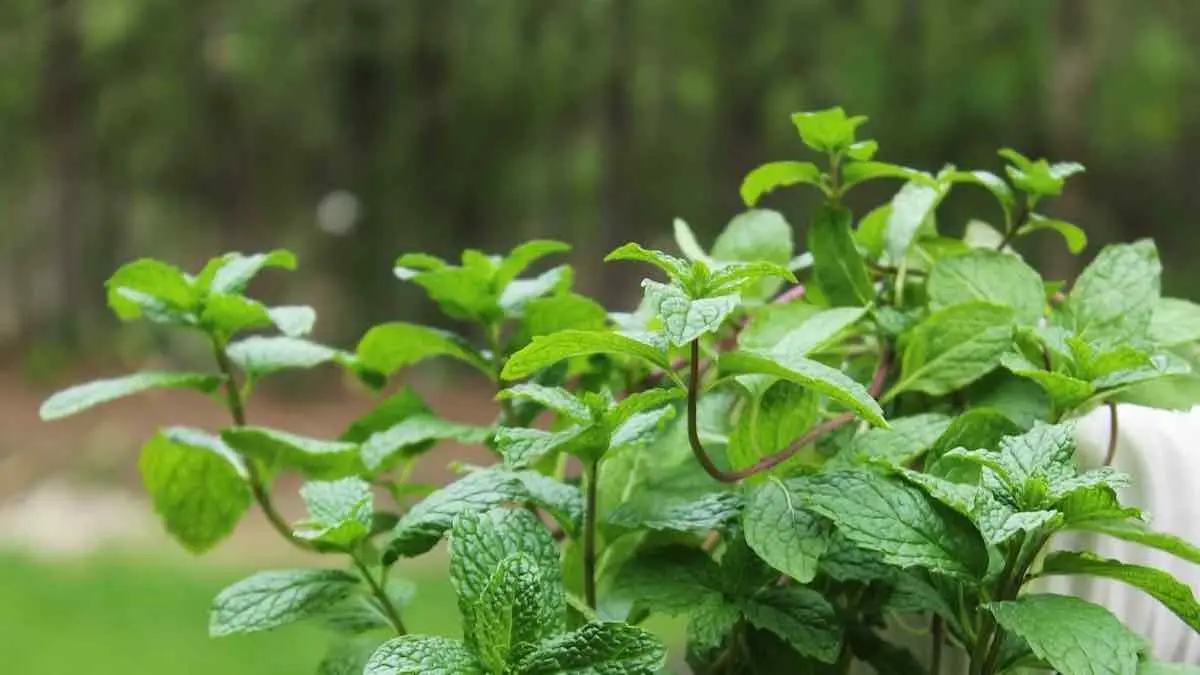Table of contents
Mint Growing Tips
If you are looking to add a burst of flavour to your gardens, mint growing is an excellent way to do so. Mint is a vigorous herb that thrives in sun and shade and requires little effort or maintenance to grow.
From planting tips to harvesting advice, this guide has everything you need to know about growing mint in your garden.
Mint is a hardy herb that grows best in the tropics. It prefers warm temperatures, moist soil, and plenty of sunlight. When planting mint, make sure to give it enough room to spread out.
This easy-to-grow herb can be used in salads, teas, and many other dishes, so read on for our mint growing tips.
How long does mint take to grow?
It takes mint 90 days to reach maturity.
How to Grow Mint from Cuttings
You can easily propagate mint by taking a cutting and planting it in new soil. Simply lift a section of mint up, removing roots from the soil and use a pair of scissors to cut off around 8 inches of the plant. Then carefully transplant it into your garden or pot.
Time needed: 3 minutes
How to grow mint from cuttings.
- Obtain cutting.
Prune off vigorous new shoots. Cut stems about 8-10 cm (3-5 in) long.
- Place in Water
Place cutting in a glass of water on a sunny windowsill to quickly develop roots.
- Plant Cutting
Remove shoots that have started sprouting and put these in pots of quality potting mix.
- Mulch
Mulch around your mint with lucerne or pea straw.
How to Grow Mint from Seed
Growing mint from seed can be a rewarding process, but it requires some patience and care as mint seeds have a lower germination rate compared to other herbs. Here’s a step-by-step guide on how to successfully grow mint from seed.
- Purchase high-quality mint seeds from a reputable supplier. Common varieties include spearmint and peppermint.
- Fill seed trays or small pots with a seed starting mix. Ensure the mix is moist but not waterlogged as mint prefers a well-draining, light soil mix.
- Scatter the mint seeds thinly on the surface of the soil. Lightly press the seeds into the soil without covering them completely, as they need light to germinate.
- Mist the soil surface lightly with water using a spray bottle. Cover the trays or pots with plastic wrap or a humidity dome to maintain moisture and humidity. Place the seed trays or pots in a warm, bright location. Mint seeds require light to germinate.
- Once the seedlings have grown to about 2 inches tall and have a couple of sets of true leaves, thin them out to avoid overcrowding. When the seedlings are about 4-6 inches tall and have several sets of true leaves, they can be transplanted.
- Choose a location with partial shade to full sun and well-draining soil.
- Keep the soil consistently moist but not soggy. Mint likes regular watering, especially in hot, dry weather.
- Mint doesn’t require much fertilisation. A balanced, all-purpose fertilizer applied once a month is usually sufficient.
- Pest Control: Watch out for common pests like aphids and spider mites. Use insecticidal soap or neem oil if necessary.
- You can start harvesting mint leaves once the plant is well-established, usually about 3-4 months after germination.
By following these steps and providing the right conditions, you can successfully grow mint from seed and enjoy its fresh, aromatic leaves in your culinary dishes and teas.
Mint Growing Season
In the tropics you can grow mint all year around. It loves tropical conditions.
Mint Growing Season Australia
In Australia’s southern states, mint can be grown throughout most of the year, but it thrives especially well during the warmer months of spring and summer.
Mint is quite hardy, so even outside of its peak growing season, you can often find it surviving with proper care. Regular harvesting encourages new growth, ensuring a continuous supply of fresh mint leaves.
Mint Growing Conditions
As with other plants in your garden, mint needs the right environment to grow. Select a spot for your mint that gets at least 6 hours of sun in the summer and partial shade in the winter.
Mint does well under trees, as well as along fences and borders. When planting, allow your plants enough room to spread out and don’t overcrowd them too much as this will cause them to compete for water and nutrients.
Mint is a hardy plant, but it still needs well-draining soil to thrive. Choose a spot in your garden that gets plenty of sun and add several inches of organic material such as compost or aged manure before planting. This will not only provide essential nutrients to the soil but help keep it from compacting and draining too slowly.
Mint Growing in Pots
During the wet season you should ensure your mint does not have constantly soggy soil and that your soil has a chance to drain. So we suggest growing your herbs in containers or pots using well draining soil.
Make sure your pot or container has good drainage in order to prevent standing water around the plants, which can lead to root rot.

How to Grow Mint indoors
Simply sprinkle the seeds onto the surface of your potting mix. Press down gently to ensure good contact. Then cover with a little sprinkle of additional potting mix.
Light is needed for germination, so place the container into a bright spot out of direct sunlight, water well and keep moist until germination (in around 10 to 14 days). Mint loves the sun and will produce higher yields. Bright windowsills are always a great spot for your plant.
Keep the soil moist but not overly wet and be sure not to let it dry out too much. If you live in a warmer climate, you may need to water up to twice daily.
Mint Growing Problems
When growing mint in your garden, be sure to plan ahead and prepare effective control strategies from the start. Mint is usually resistant to most common garden pests and diseases.
However, if left unchecked, some insects or fungi may become a problem. Consider using organic pest controls such as companion planting or using natural predators to keep your mint safe from harm.
Regular application of ‘white oil’ can help address these pests. Indeed white oil is an effective organic pesticide that you can make at home.
Neem oil is also an organic solution you can apply. It will help to combat certain insects and fungal diseases.
Prune to Encourage Healthy Mint Growing
Pruning mint regularly is essential for healthy growth and to prevent it from taking over your garden. Pinch or trim off the tips of the stems when they have 4-6 sets of leaves and your plant will come back fuller, bushier, and fresher than before.
Make sure to be consistent with pruning as it encourages the growth of new shoots, improving the overall health of your mint plants.
Health Benefits of Mint
Mint plants have been used throughout history for medicinal purposes. These uses include helping with gut health, reducing allergy symptoms and soothing symptoms of the common cold.
Antioxidants
In addition mint is a potent source of antioxidants (compared to other herbs and spices). These antioxidants help protect your body from oxidative stress, a type of damage to cells caused by free radicals.
Other Tropical Herbs
- Grow Basil at Home
- Cilantro
- Dill
- Garlic Chives
- Ginger
- Lemongrass
- Stevia
- Thai Chili
- Vietnamese Mint Growing (laksa leaf)

